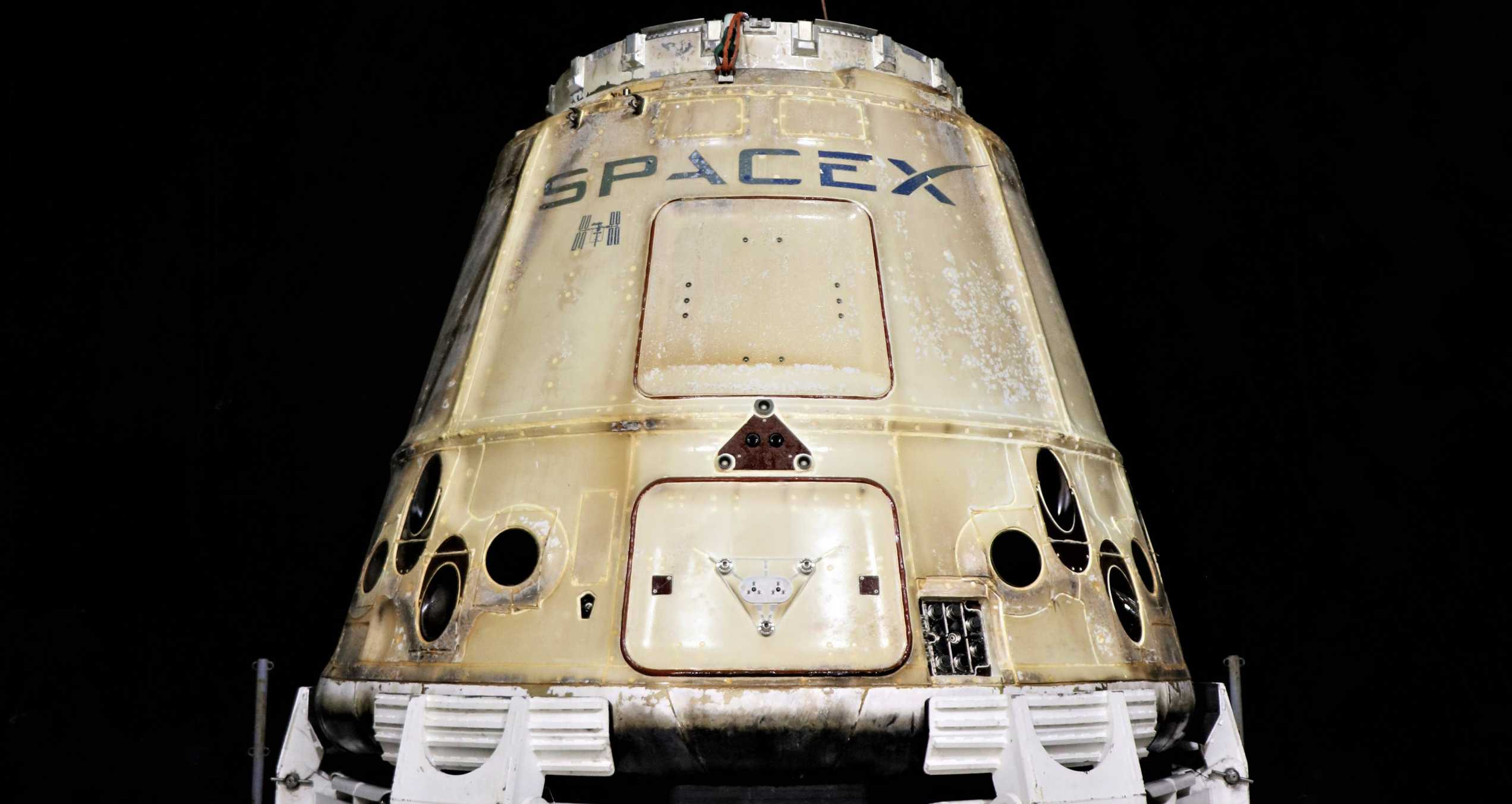
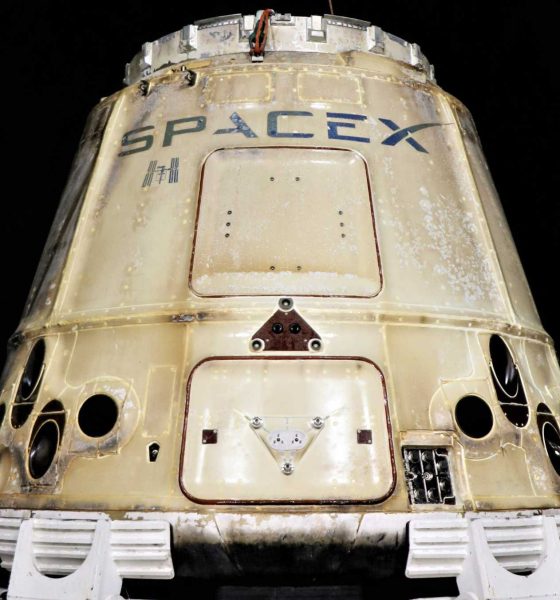
News
SpaceX Dragon spacecraft returns to California port for the last time
SpaceX has returned one of its reusable Dragon spacecraft to the Port of Los Angeles for the last time, wrapping up almost a decade of West Coast recovery operations as the company prepares to move East.
Marking the fully successful completion of Cargo Dragon’s CRS-20 space station resupply mission for NASA, the spacecraft’s arrival in port aboard recovery vessel NRC Quest is SpaceX’s 21st since December 2010. CRS-20 was the original Cargo Dragon spacecraft’s very last mission, meaning that the historic vehicle will have effectively entered retirement once SpaceX has finished capsule C112’s post-flight processing. More likely than not, it and its siblings may soon find themselves displayed in SpaceX facilities and aerospace museums across the US, a fitting end for an orbital spacecraft that effectively launched SpaceX onto the world’s spaceflight stage.
Cargo Dragon is by no means the last of its kind, however. SpaceX has already launched Crew Dragon – also known as Dragon 2 – on a flawless March 2019 orbital debut. An uncrewed variant of the same upgraded spacecraft will soon replace Cargo Dragon for uncrewed space station resupply missions under a second NASA Commercial Resupply Services contract (CRS2). For a variety of reasons, SpaceX has decided to move all Dragon 2 recovery operations to its Port Canaveral, Florida hub, now also the sole home of Falcon booster drone ship recoveries and payload fairing catch attempts. This means that April 9th’s Cargo Dragon homecoming is the last time a SpaceX spacecraft will return to the West Coast — a bittersweet end of an era.
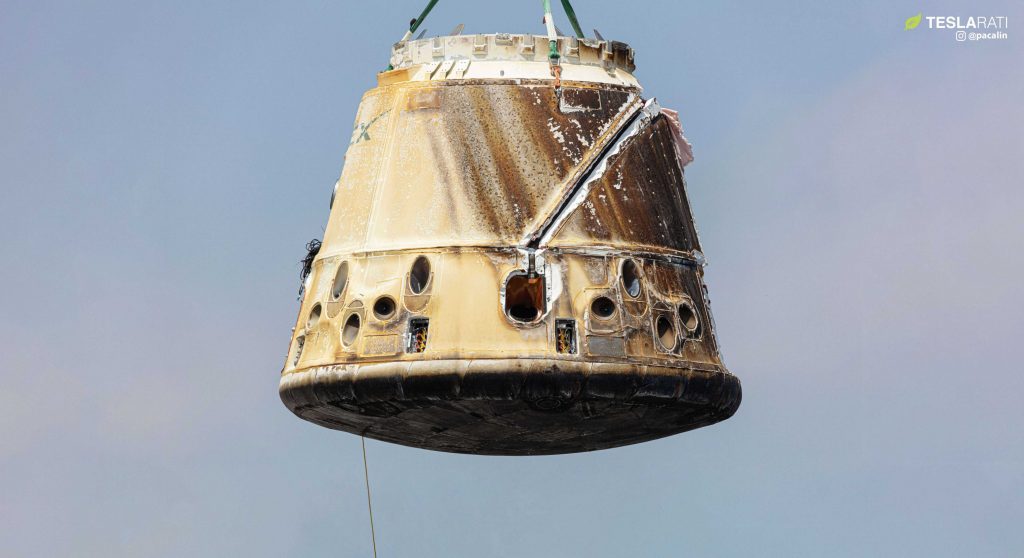
Upon its safe return to shore, Cargo Dragon C112 is now the third Dragon spacecraft to successfully complete three separate orbital resupply missions, as well as the ninth Dragon reuse overall. While the recovered spacecraft may look like a very well-toasted marshmallow, all that visible wear and tear comes from a single orbital-velocity reentry, as SpaceX extensively refurbishes each Dragon before they are reused.
Before Cargo Dragon C112 lifted off on a Falcon 9 rocket for the third time on March 7th, it looked about as pristine as it did the first time it departed SpaceX’s Hawthorne, California factory in 2016. Aside from a duo of International Space Station badges added to the spacecraft’s exterior, it is functionally and visually identical, although parts of the capsule – like landing parachutes and its ablative heat shield – must be replaced after each mission.
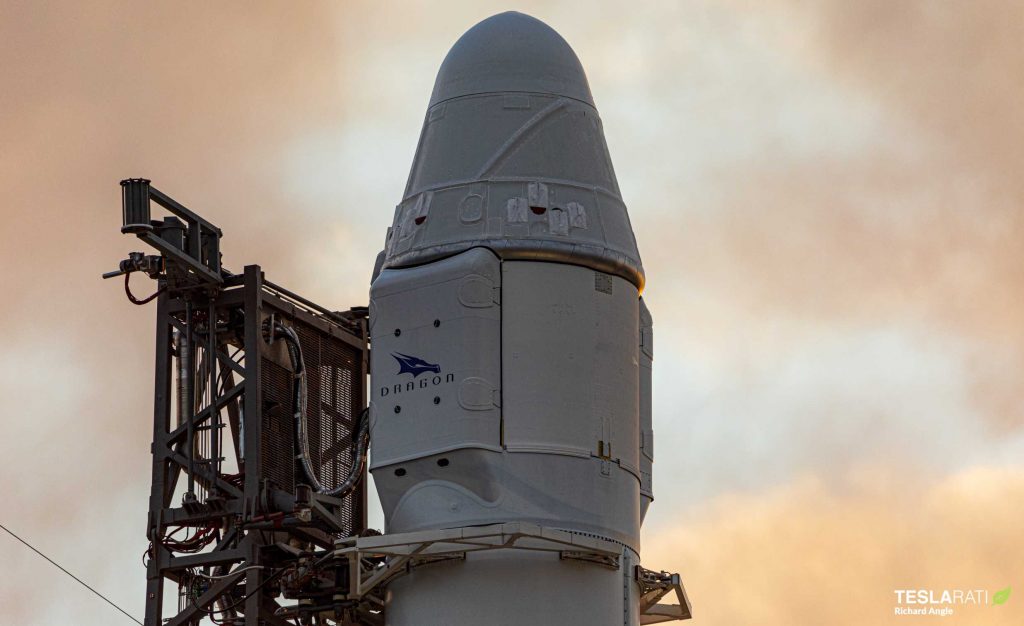
Still, despite having to clean and resurface the spacecraft’s white thermal protection, replace heat shields, fabricate new disposable trunk sections, and much more for every launch, SpaceX CEO Elon Musk has stated that even the first Dragon reuse (likely the most expensive) was at least 50% cheaper than building a new spacecraft. Additionally, SpaceX clearly began to find its stride on Dragon capsule C112’s CRS-20 refurbishment, completing the process with record-breaking speed.
As previously discussed on Teslarati, “measured from splashdown to the capsule’s shipment to the launch pad, SpaceX may have spent less than a year refurbishing Cargo Dragon C112, potentially more than a 50% faster than all prior Dragon refurbishment operations.” Cargo Dragon’s Dragon 2 replacement is expected to be far easier to refurbish, while also potentially allowing for up to five orbital missions per spacecraft, while Dragon 1’s design was capped at three missions.
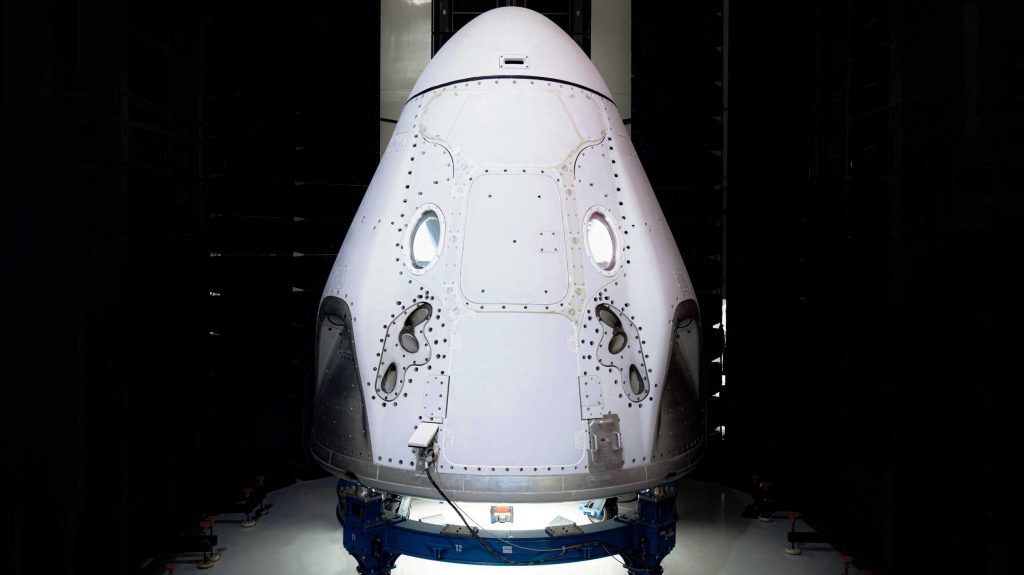
CRS-21 – SpaceX’s first NASA CRS2 mission and the first planned Cargo Dragon 2 launch – is scheduled for no earlier than (NET) October 2020. Meanwhile, Crew Dragon’s “Demo-2” astronaut debut is set to launch as early as late May. If successful, NASA says Crew Dragon’s first operational astronaut launch could happen as early as a month or two after splashdown (~Q4 2020).
After completing their orbital duties, all of those upgraded Dragon spacecraft are scheduled to reenter and splash down in the Atlantic Ocean, where they will be brought back to Cape Canaveral for processing and refurbishment. In the event that weather in the Atlantic Ocean is unacceptable for recovery operations, SpaceX has developed a backup recovery zone in the Gulf of Mexico. In short, it’s possible that Cargo Dragon’s April 7th Port of Los Angeles return will be the last time ever that the US West Coast supports orbital spacecraft recovery operations.

News
Elon Musk’s Grokipedia surges to 5.6M articles, almost 79% of English Wikipedia
The explosive growth marks a major milestone for the AI-powered online encyclopedia, which was launched by Elon Musk’s xAI just months ago.

Elon Musk’s Grokipedia has grown to an impressive 5,615,201 articles as of today, closing in on 79% of the English Wikipedia’s current total of 7,119,376 articles.
The explosive growth marks a major milestone for the AI-powered online encyclopedia, which was launched by Elon Musk’s xAI just months ago. Needless to say, it would only be a matter of time before Grokipedia exceeds English Wikipedia in sheer volume.
Grokipedia’s rapid growth
xAI’s vision for Grokipedia emphasizes neutrality, while Grok’s reasoning capabilities allow for fast drafting and fact-checking. When Elon Musk announced the initiative in late September 2025, he noted that Grokipedia would be an improvement to Wikipedia because it would be designed to avoid bias.
At the time, Musk noted that Grokipedia “is a necessary step towards the xAI goal of understanding the Universe.”
Grokipedia was launched in late October, and while xAI was careful to list it only as Version 0.1 at the time, the online encyclopedia immediately earned praise. Wikipedia co-founder Larry Sanger highlighted the project’s innovative approach, noting how it leverages AI to fill knowledge gaps and enable rapid updates. Netizens also observed how Grokipedia tends to present articles in a more objective manner compared to Wikipedia, which is edited by humans.
Elon Musk’s ambitious plans
With 5,615,201 total articles, Grokipedia has now grown to almost 79% of English Wikipedia’s article base. This is incredibly quick, though Grokipedia remains text-only for now. xAI, for its part, has now updated the online encyclopedia’s iteration to v0.2.
Elon Musk has shared bold ideas for Grokipedia, including sending a record of the entire knowledge base to space as part of xAI’s mission to preserve and expand human understanding. At some point, Musk stated that Grokipedia will be renamed to Encyclopedia Galactica, and it will be sent to the cosmos.
“When Grokipedia is good enough (long way to go), we will change the name to Encyclopedia Galactica. It will be an open source distillation of all knowledge, including audio, images and video. Join xAI to help build the sci-fi version of the Library of Alexandria!” Musk wrote, adding in a later post that “Copies will be etched in stone and sent to the Moon, Mars and beyond. This time, it will not be lost.”
News
Tesla Model 3 becomes Netherlands’ best-selling used EV in 2025
More than one in ten second-hand electric cars sold in the country last year was a Tesla Model 3.

The Tesla Model 3 became the most popular used electric car in the Netherlands in 2025, cementing its dominance well beyond the country’s new-car market.
After years at the top of Dutch EV sales charts, the Model 3 now leads the country’s second-hand EV market by a wide margin, as record used-car purchases pushed electric vehicles further into the mainstream.
Model 3 takes a commanding lead
The Netherlands recorded more than 2.1 million used car sales last year, the highest level on record. Of those, roughly 4.8%, or about 102,000 vehicles, were electric. Within that growing segment, the Tesla Model 3 stood far ahead of its competitors.
In 2025 alone, 11,338 used Model 3s changed hands, giving the car an 11.1% share of the country’s entire used EV market. That means more than one in ten second-hand electric cars sold in the country last year was a Tesla Model 3, Auto Week Netherlands reported. The scale of its lead is striking: the gap between the Model 3 and the second-place finisher, the Volkswagen ID3, is more than 6,700 vehicles.
Rivals trail as residual values shape rankings
The Volkswagen ID.3 ranked a distant second, with 4,595 used units sold and a 4.5% market share. Close behind was the Audi e-tron, which placed third with 4,236 registrations. As noted by Auto Week Netherlands, relatively low residual values likely boosted the e-tron’s appeal in the used market, despite its higher original price.
Other strong performers included the Kia Niro, the Tesla Model Y, and the Hyundai Kona, highlighting continued demand for compact and midsize electric vehicles with proven range and reliability. No other model, however, came close to matching the Model 3’s scale or market presence.
News
Tesla Model Y Standard Long Range RWD launches in Europe
The update was announced by Tesla Europe & Middle East in a post on its official social media account on X.

Tesla has expanded the Model Y lineup in Europe with the introduction of the Standard Long Range RWD variant, which offers an impressive 657 km of WLTP range.
The update was announced by Tesla Europe & Middle East in a post on its official social media account on X.
Model Y Standard Long Range RWD Details
Tesla Europe & Middle East highlighted some of the Model Y Standard Long Range RWD’s most notable specs, from its 657 km of WLTP range to its 2,118 liters of cargo volume. More importantly, Tesla also noted that the newly released variant only consumes 12.7 kWh per 100 km, making it the most efficient Model Y to date.
The Model Y Standard provides a lower entry point for consumers who wish to enter the Tesla ecosystem at the lowest possible price. While the Model 3 Standard is still more affordable, some consumers might prefer the Model Y Standard due to its larger size and crossover form factor. The fact that the Model Y Standard is equipped with Tesla’s AI4 computer also makes it ready for FSD’s eventual rollout to the region.
Top Gear’s Model Y Standard review
Top Gear‘s recent review of the Tesla Model Y Standard highlighted some of the vehicle’s most notable features, such as its impressive real-world range, stellar infotainment system, and spacious interior. As per the publication, the Model Y Standard still retains a lot of what makes Tesla’s vehicles well-rounded, even if it’s been equipped with a simplified interior.
Top Gear compared the Model Y Standard to its rivals in the same segment. “The introduction of the Standard trim brings the Model Y in line with the entry price of most of its closest competition. In fact, it’s actually cheaper than a Peugeot e-3008 and costs £5k less than an entry-level Audi Q4 e-tron. It also makes the Ford Mustang Mach-E look a little short with its higher entry price and worse range,” the publication wrote.








